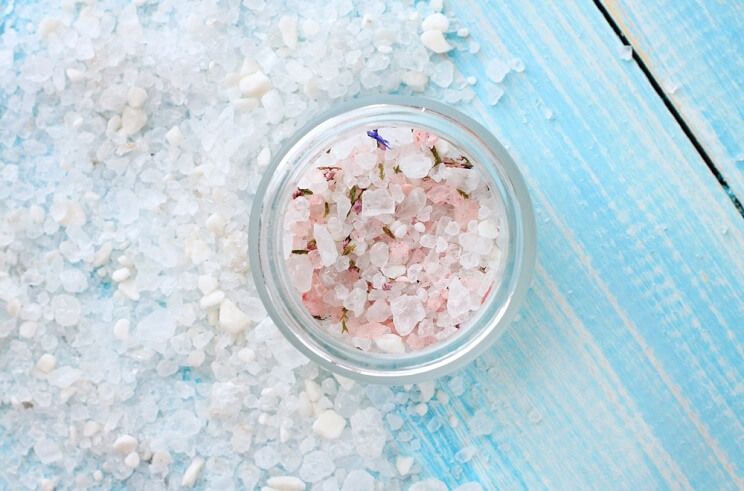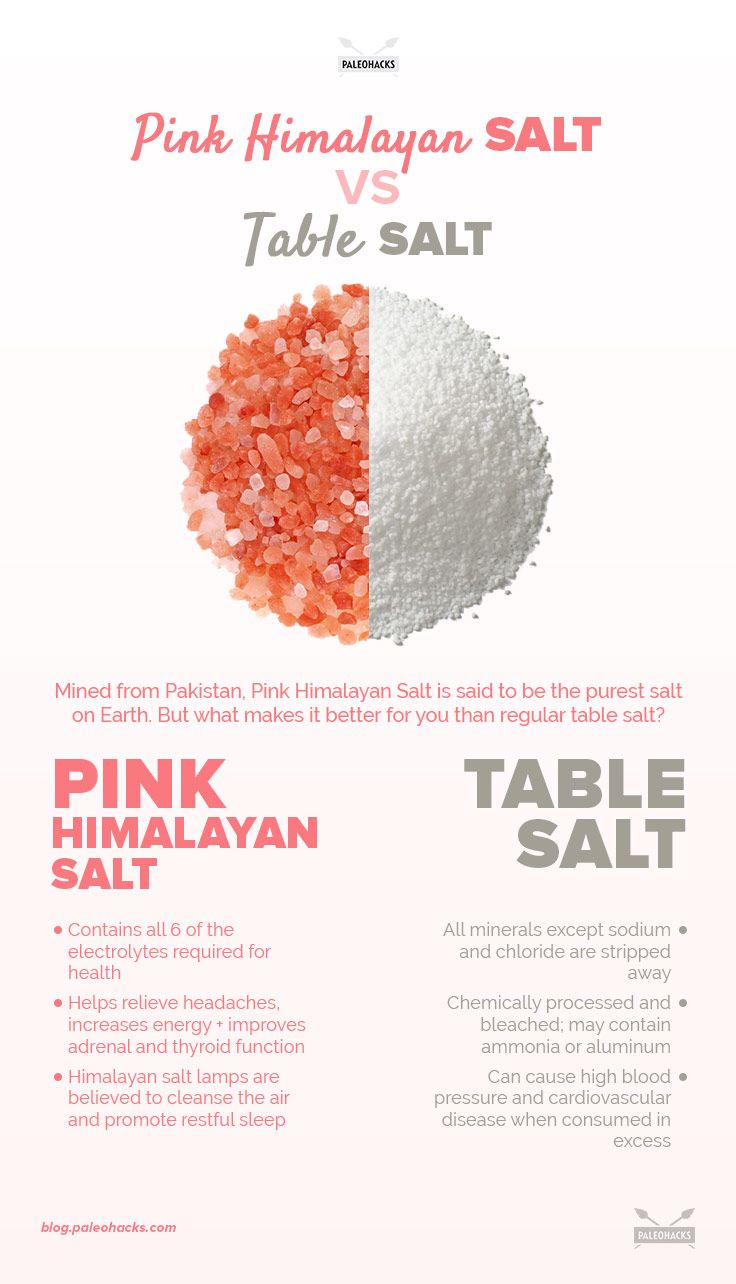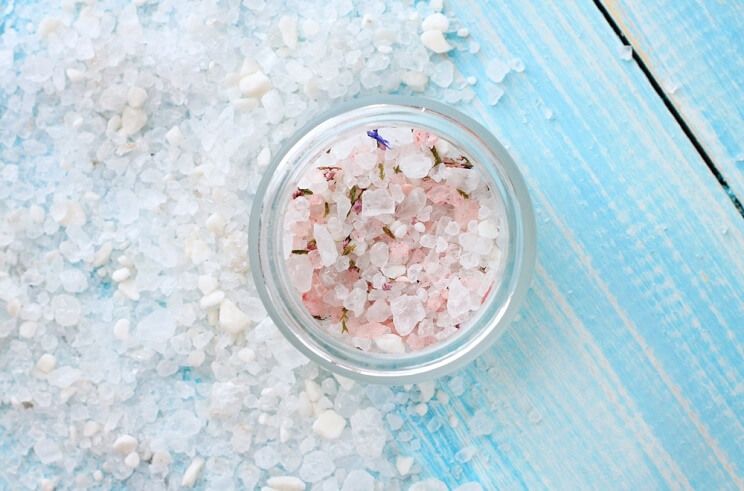Himalayan salt, also known as pink rock salt, in Pakistani salt mines approximately 186 miles (300 kilometers) from the Himalayas. The rock is a pale pink color stemming from iron oxide deposits (rust) in the mountains (1). Many people believe it has many health benefits and is the purest salt on earth.
As with all varieties of salt, Himalayan rock salt is most commonly used for cooking. But in addition to boosting food flavor, Himalayan salt helps relieve migraines, increase energy and improve adrenal function.
But Wait… Isn’t Salt Bad for You?

Salt has come a long way from being a highly valued precious element and form of currency. Now days, it’s become a controversial and somewhat demonized “anti-nutrient.” Consequently, people consuming excess sodium can suffer from high blood pressure, stroke and cardiovascular disease (2).
When people consume it in excess, the salt binds to water in their bloodstream and raises blood pressure (3). But the way we consume salt in the Standard American Diet is in the form of highly processed table salt.
How Are Salts Different?
Table salt differs from naturally occurring salt because all of its minerals. Manufacturers strip our natural potassium during the refining process (4). This is damaging to health because it interferes with your body’s natural sodium and potassium balance.
For instance, sodium and potassium work together in a specific ratio to regulate blood pressure. But when sodium levels are too high, they interfere with blood pressure levels being balanced—resulting in hypertension (5). As you can guess, this isn’t a concern with unrefined salt because it still contains potassium.Natural salt has all the essential minerals that are stripped away in refined salts.
When manufacturers chemically process and bleach table salt, they add other downsides. This kind of salt may typically contain added chemicals, such as ammonia or aluminum, that are harmful to our health (6). Aluminum is toxic to the body and has been linked to neurodegenerative disorders like Alzheimer’s disease (7).
Therefore, the negative effects of isolating sodium chloride in processed salt gives it a bad reputation. Additionally, it’s easy to overwhelm our bodies with processed salt by eating refined foods at every meal.
But when we remove processed foods from our diet and receive unrefined salt from natural sources, it’s actually good for us. Fruits, vegetables, seaweed, salt water, and salt from the Himalayan rock salt mines, are all examples of natural salt sources. In fact, our bodies depend on it for survival.
Why We Need Unrefined Salt in Our Diets

Furthermore, sodium in salt works with potassium. Despite negative associations we have with sodium, our bodies depend on it to regulate muscular contractions. They also help aid in nerve impulses, cardiac function, and maintaining fluid balance in our bodies (8).
Chloride works with sodium to regulate nerve impulses and also plays a role in digestion. When chloride combines with hydrogen, it forms hydrochloric acid in the stomach. This allows us to digest protein (9). Since our bodies depend on protein to form hemoglobin – like red cells carrying oxygen through our bodies – chloride is an element that gives us life.
As mentioned above, unprocessed salt contains several other trace minerals that are needed for health. Things like calcium, magnesium and iodine are just a few of these examples. Perhaps this is why new studies suggest consuming too little salt is actually a greater risk to health (10).Himalayan pink salt and other natural salts are vital for organ functioning.
Therefore, when you’re eating unprocessed foods, you’re adding small amounts of unrefined salt to your diet without threatening your health. Instead, natural salt provides your body with several minerals vital to organ function.
The bottom line when it comes to dietary salt is that the source matters.
Many table salt manufacturers chemically produce and strip important minerals out of the final product. Because of this, processed salt is considered unhealthy. Salt from natural sources contains several trace elements necessary to our health. This means salt from nature is healthier.
Now that we’ve briefly touched on the never-ending salt debate, let’s take a closer look at the health benefits of Himalayan rock salt.
Health Benefits of Himalayan Salt

Himalayan contains 84 trace minerals and electrolytes. Some of these minerals include calcium, iodine, potassium, magnesium and iron (11). In fact, Himalayan salt contains triple the amount of potassium, per serving, than Maldon or Celtic sea salt (12).
While lacking scientific evidence, high mineral content in Himalayan rock salt attributes to many health benefits. Here are four things people believe Himalayan rock salt helps with:
1. Electrolyte Balance
Himalayan salt contains all six electrolytes we require for health: sodium, potassium, chloride, magnesium, phosphorus and calcium. Therefore, you can replenish your body’s natural supply of electrolytes by adding Himalayan rock salt to your diet. This is especially helpful on hot days or after an intense workout when electrolytes are lost through sweat.
You can make a natural “gatorade” with Himalayan rock salt by adding ¼ teaspoon of Himalayan rock salt to 1 quart (1 liter) of water, with the juice of half a lemon and some raw honey or green leaf stevia.
2. Thyroid Function
Since Himalayan rock salt contains iodine – the element your body needs to synthesize thyroid hormones – it may help promote and maintain healthy thyroid function.
Research links Iodine deficiency to hypothyroidism. It’s a common condition primarily present in countries such as India, Asia and Africa (13). As a preventative measure against iodine deficiency, synthetic iodine gets added back into table salt (also known as iodized salt).
Now, to state the obvious: unrefined salt already contains iodine. So, why not get iodine from a natural source, like Himalayan rock salt?
3. Adrenal Health
Your adrenals are two little glands sitting on top of your kidneys. They’re responsible for regulating your body’s stress response by producing the hormones cortisol and adrenaline (14).
Your adrenal glands depend on minerals for proper function. You can find minerals like sodium and potassium in Himalayan rock salt. Ideal sodium and potassium balance
Promoting adrenal health is important to preventing chronic fatigue, burnout, and other hormone imbalances — such as hypothyroidism.
4. Migraine Relief
Researchers suggest a primary cause of migraines and headaches comes from magnesium deficiency.
Since Himalayan rock salt contains magnesium, people often use it as a natural remedy for migraine relief. Himalayan rock salt also contains calcium, helping to relax constricted blood vessels (16).
Himalayan Salt vs. Other Varieties of Salt

The mineral content of Himalayan rock salt is what makes it so appealing. But is it any better than other varieties of natural salt – such as Celtic or Maldon sea salt?
In terms of nutritional content, Celtic sea salt has less sodium than Maldon and Himalayan sea salt. It’s also shown to be slightly higher in calcium, magnesium and iron. However, Himalayan rock salt contains nearly double the amount of potassium than Celtic sea salt (17). Additionally, Himalayan rock salt contains moderate levels of all minerals. Ideally though, both Celtic and Himalayan rock salt are ideal to include in your diet.
Maldon sea salt is higher in sodium than both Celtic and Himalayan salt. It’s also low in potassium, magnesium and iron – making it the less favorable choice.
Where to Buy Himalayan Salt

People can purchase Himalayan rock salt at any health or ethnic food store. If you’re looking for quality, look for a darker pink salt indicating higher mineral content.
There are different varieties and brands of Himalayan rock salt. Consumers can purchase certified halal or kosher for religious reasons or by type of grind (course or fine). Many brands claim their Himalayan rock salt comes directly from mines in the Himalayan Mountains. People believe this indicates higher quality and greater mineral content.
There’s no harm in adding Himalayan rock salt to your diet in small amounts. In fact, replacing table salt with Himalayan rock salt can be good for you. It’s an effortless way to add more trace minerals to your diet and improve your overall health.

